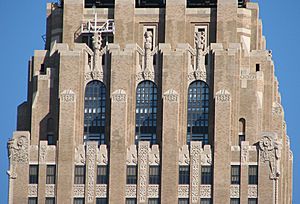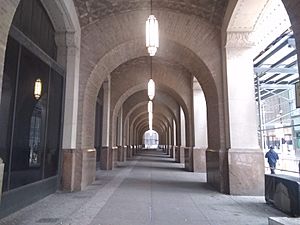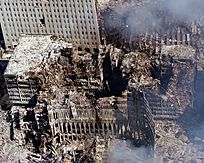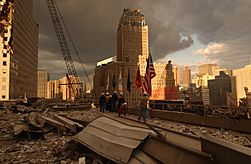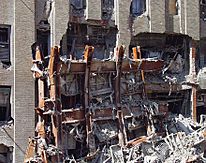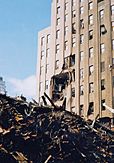Verizon Building facts for kids
|
Barclay-Vesey Building
New York Telephone Co. Building |
|
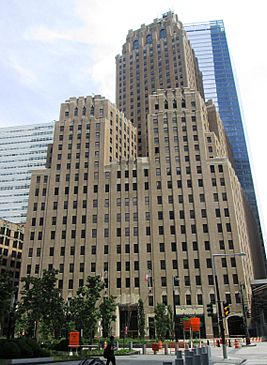
Western facade in 2013
|
|
| Location | 140 West Street Manhattan, New York |
|---|---|
| Area | 0.9 acres (0.36 ha) |
| Built | 1923–1927 |
| Architect | Ralph Walker |
| Architectural style | Art Deco |
| NRHP reference No. | 09000257 |
Quick facts for kids Significant dates |
|
| Added to NRHP | April 30, 2009 |
The Verizon Building is a tall building in Lower Manhattan, New York City. It is also known as 100 Barclay or the Barclay–Vesey Building. This 32-story building was designed by Ralph Thomas Walker in the Art Deco style. It was one of the first skyscrapers built in this popular style.
The building stands on a whole city block near the World Trade Center. It was built between 1923 and 1927. For many years, it was the main office for the New York Telephone Company and later for Verizon.
On September 11, 2001, the building was badly damaged when the nearby World Trade Center towers fell. It took three years and a lot of money to fix it. In 2016, part of the building was turned into fancy apartments called 100 Barclay.
People who study buildings really like the Verizon Building's design. It was added to the National Register of Historic Places in 2009. Its outside and first floor inside are also special city landmarks.
Contents
Where is the Verizon Building?
The Verizon Building is located in Lower Manhattan. It sits between the Financial District and Tribeca neighborhoods. The building takes up an entire city block.
It is bordered by West Street to the west and Washington Street to the east. Barclay Street is to the north, and Vesey Street is to the south. The new World Trade Center is right next to it.
Before the 1800s, this area was part of the Hudson River shoreline. Later, the land was filled in. A market called the Washington Market used to be on this spot.
What does the Verizon Building look like?
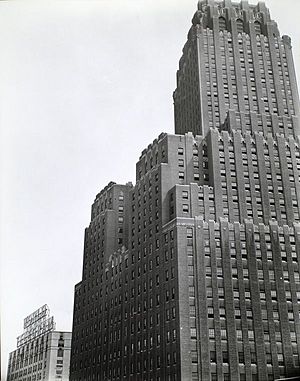
The Verizon Building is about 498 feet (152 meters) tall. It has 32 main stories. It was designed in the Art Deco style, which was very modern at the time. Many people consider it the first Art Deco skyscraper.
The architect, Ralph Walker, wanted the building to look as modern as the telephone technology inside. He used ideas from other famous building designs. Walker later designed other Art Deco buildings in New York City.
Building Shape and Setbacks
The Verizon Building has many "setbacks." These are parts of the building that step back as it gets taller. In New York City, setbacks were required by law. This was to make sure enough light and air reached the streets below.
The bottom ten floors of the building cover the entire city block. Above the 10th floor, the building steps back. This creates an "H" shape on floors 11 to 17. A smaller tower rises above the 17th floor.
The building's shape was also planned for its inside use. Areas like the telephone operating system did not need sunlight. These were placed in the center of the building. This allowed the lower floors to cover the whole block.
Outside Design
The outside of the building is covered with brick in shades of green, gold, and buff. The architect, Ralph Walker, liked these materials for their look and feel. The upper floors have stone decorations. The lower floors have detailed patterns and limestone designs.
The building also has vertical stone columns called "piers." These, along with the stepped-back shape, give the building a unique look. The outside walls are very thick and strong. This helps protect the steel frame inside.
Walker wanted the building's decorations to be interesting. He avoided old-fashioned designs. The decorations include complex leaves, baby faces, and animal heads. There is also a bell above the main door, which represents the telephone company.
Ground Level Details
The main entrances are on West and Washington Streets. These entrances are large and have bronze doors. Above the doors are bronze screens with designs of vines and grapes. These used to have bell designs too.
On the Vesey Street side, there is a covered walkway called an arcade. It has 12 arches and a vaulted ceiling made of special tiles. This arcade was built because the city wanted to widen the street. It was once a shopping area, but now it is mostly office space.
The north side also has storefronts under arches. Some of these arches were changed into garage openings.
Upper Story Windows
From the second floor up, the windows mostly look the same. Most have three-over-three sash windows. Some windows are covered with grates where there is equipment inside.
The windows on the second floor have fancy triangular stone designs. These carvings show birds, grapes, and vines. The third-floor windows also have grape and vine carvings. Windows on higher floors are simpler. Each window section is separated by vertical limestone piers.
More stone decorations are found above the 20th floor. For example, on the 29th floor, there are elephant heads carved into the corners. The top floors have tall arched windows.
Inside the Verizon Building
Ralph Walker believed the building should work like a "machine" for the people inside. The inside design matches the outside style. This was unusual for buildings at the time. The inside walls are also made of strong materials like brick and concrete.
The building has a huge amount of space inside. It was designed with two separate mechanical sections. The 17th floor holds the main mechanical equipment. This was unique, as most buildings put this equipment on the roof or in the basement.
There are 26 elevators to take people to the upper floors. Different sets of elevators serve different parts of the building.
Lobby
The main lobby connects the West and Washington Street entrances. It has a high, arched ceiling. The walls and floors are made of beautiful, light-colored marble.
In the middle of the lobby, there are areas that lead to the elevators. These elevator areas have painted ceilings and fancy bronze lights. There is also a special area for telephones. Today, the western part of the lobby is still used by Verizon. The eastern part is a lounge for residents.
The lobby's decorations are also in the Art Deco style. The elevator doors have bronze frames. Other doors and columns are made of dark marble. The bronze decorations include grape and vine designs.
The floor of the lobby has bronze pictures. These show how the telephone system was built. One picture shows a female telephone operator. Another shows a lineworker (someone who works on telephone lines).
The ceiling has twelve murals, which are large paintings. These murals show the history of human communication. They go from ancient methods, like Aztec runners, to the modern telephone. Fancy bronze chandeliers hang from the ceiling.
Other Floors
The first ten floors above the basements were used for telephone offices. These floors were built to hold heavy equipment. The 29th floor had New York Telephone's main offices. The 31st floor had a large room for 6,500 workers.
When the building first opened, it had an auditorium and a gym. There was also a training school for workers.
Today, the floors above the 10th floor have been turned into 157 luxury apartments. There is a separate entrance for residents on Barclay Street. The largest apartment, called a penthouse, is on the 31st and 32nd floors. It is huge, with a very big living room.
The residential part of the building also has many cool features. These include a swimming pool, a wine-tasting room, a billiards room, a music practice room, a fitness center, and a children's playroom.
The Verizon Building has five basement levels. These basements hold important communications equipment. At the time of the 9/11 attacks, the building was a major telephone switching center. It handled hundreds of thousands of phone lines.
Building History
Planning and Construction
After World War I, the New York Telephone Company grew very fast. They decided they needed one big building for all their offices. They bought the entire city block where the Verizon Building now stands. This area was chosen because the land was cheaper than other parts of the city.
In 1923, the company announced plans for their new headquarters. It would hold 6,000 employees and a lot of telephone equipment. Ralph Walker, a young architect, was chosen to design it. He wanted to create a strong image for the company.
Walker tried out many different designs and styles. He finally chose the 32-story Art Deco design with setbacks. This design was the most efficient.
Building the foundation was tricky. The site was on filled land near the river, so water often leaked in. Workers had to build a special wall to keep the water out. They used new steel supports, which saved money.
Almost 700 workers were on the job at all times. They worked together to build the steel frame and floors quickly. The first employees moved into the building in 1926. The whole building was finished by April 1927.
20th Century Use
The building started with four telephone exchanges. These helped connect many phone calls in Lower Manhattan. Over time, more equipment was added, and some office space was removed.
In the 1970s, the company's main offices moved out of the building. However, the important telephone switching centers stayed. In 1984, the building became the headquarters for NYNEX. Later, in 2000, it became the headquarters for Verizon Communications.
In 1991, the outside and ground-floor lobbies of the building were named city landmarks. This meant they were special and needed to be protected.
21st Century Use
Damage and Restoration
On September 11, 2001, the Verizon Building was next to the Twin Towers. When the towers collapsed, falling steel beams badly damaged the south and east sides of the Verizon Building. Water mains broke, flooding the basements.
The building's strong, thick walls helped it survive. They absorbed much of the energy from the falling debris. The damage was mostly at the points where things hit the building. The ground-floor murals were also damaged by smoke.
Experts quickly checked the building after the attacks. Many companies worked together to restore it. They carefully fixed the stone carvings and the beautiful lobby murals. They even used tiny needles to inject special liquid to fix the paint.
The restoration took three years and cost $1.4 billion. Even while being repaired, the building continued to work as a telephone center. By late 2005, the restoration was complete. In 2009, the building was added to the National Register of Historic Places.
Partial Sale and Residential Conversion
In 2012, Hurricane Sandy caused flooding in the building's basements. This damaged the elevators and lobby murals again. To prevent future floods, Verizon later installed a special barrier.
In 2013, Verizon sold the top floors of the building to a developer. Verizon kept the lower floors for its offices. The developer decided to turn the upper floors into luxury apartments called 100 Barclay.
The apartments were first offered for sale in 2016. The building now has 157 condominium units. Even though some units were slow to sell, the building remains a unique mix of historic office space and modern homes.
Images for kids
-
Berenice Abbott image of the Barclay–Vesey Building, 1936
-
Piece of framing from 7 WTC up against the damaged Verizon Building
See also
 In Spanish: Verizon Building para niños
In Spanish: Verizon Building para niños


